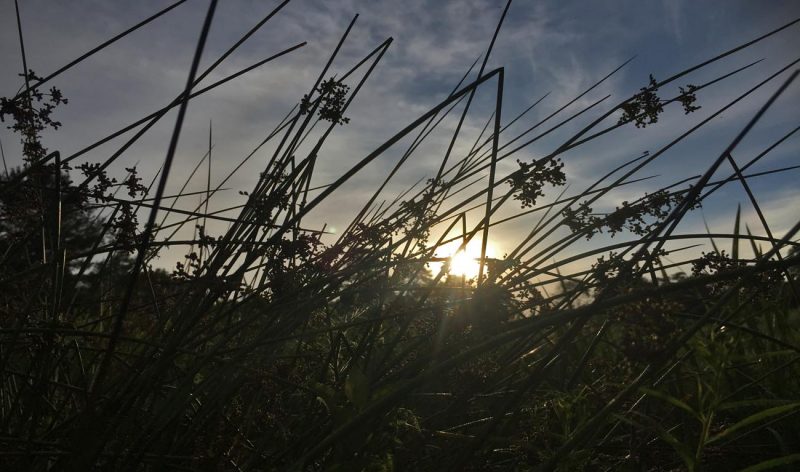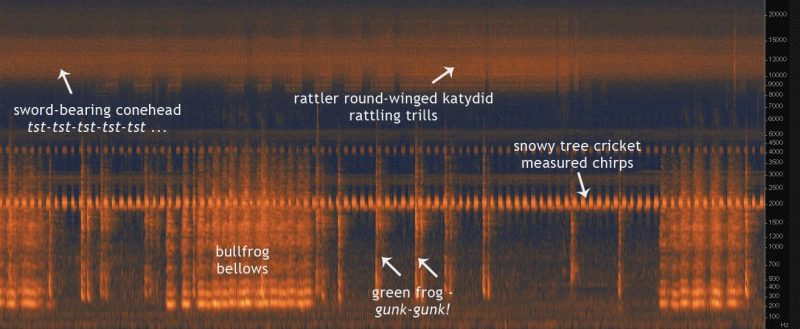 Green Frogs and Gladiator Meadow Katydids (plus other insects) singing in the middle of the night at a small farm pond. 12:30am, 24 July 2016. Near Brooktondale, New York. © Lang Elliott. Please play at a low volume to simulate a natural listening experience.
Green Frogs and Gladiator Meadow Katydids (plus other insects) singing in the middle of the night at a small farm pond. 12:30am, 24 July 2016. Near Brooktondale, New York. © Lang Elliott. Please play at a low volume to simulate a natural listening experience.
Click Here for direct link to MP3.
The season for insect song is rapidly unfolding. Here in upstate New York, it was remarkably quiet insect-wise until last weekend, when I finally heard meadow katydids, coneheads, bush katydids, and tree crickets sounding off in the dark of the night. So I jumped into action late Saturday night, hoping to capture a few pleasing insect soundscape recordings before I head off of to the Midwest (and beyond?) on Wednesday morning, in my quest for new and exciting insect compositions.
 My first stop was a small farm pond at the edge of a meadow. I arrived just after midnight and was pleased to find a nice chorus of Green Frogs (Rana clamitans), augmented by the high-pitched shuffling trills of Gladiator Meadow Katydids (Orchelilmum gladiator), the latter calling from dense grass, sedges and ferns growing in a wet seep along the edge of the pond (see habitat photo at bottom of post, taken at sunrise).
My first stop was a small farm pond at the edge of a meadow. I arrived just after midnight and was pleased to find a nice chorus of Green Frogs (Rana clamitans), augmented by the high-pitched shuffling trills of Gladiator Meadow Katydids (Orchelilmum gladiator), the latter calling from dense grass, sedges and ferns growing in a wet seep along the edge of the pond (see habitat photo at bottom of post, taken at sunrise).
To my ear, this recording is quite beautiful and sublime. The throaty calls of the Green Frogs provide a sense of depth, with individuals sounding off from various distances and directions. Listen closely for how their calls echo off the forest edge that flanks the pond on one side. Note also the subtle gurgles of water from the outlet of the pond. The soft shuffling of the Gladiator Meadow Katydids adds a high-pitched percussive element to the chorus. Do you hear the shuffles? If you have high frequency hearing loss (not uncommon, especially among us “older” folk), you may not perceive them at all.
Additional insect songs include the buzzes of two more species katydid … the Broad-winged Bush Katydid (Scudderia pistillata) and the Northern Bush Katydid (Scudderia septentrionalis). A fairly loud example of the former occurs at 1:38 and a fair example of latter may be heard at 2:48. Listen also for the very high clicks of the Northern Bush Katydid, which lead up to a buzz sequence. As with the shuffles of the meadow katydids, it is possible you will not be able to hear the songs of either species. Sadly, many insect sounds can only be appreciated by our youth, or else by adults who have managed to retain good sensitivity in the highest range of human hearing (8-20kHz).
Pleased with my frog and insect soundscape, I drove home with a cozy bed at the forefront of my mind. At about 1:30am, I pulled into our parking lot and began unloading my gear. And that’s when I became aware of a Snowy Tree Cricket, chirping in the distance. Following the sound took me straight to our little frog pond. The Snowy Tree Cricket (Orchelimum fultoni) was singing from a dense shrub at the far edge of the pond. I could hear others chirping as well. The pond itself was alive with the bellowing of Bullfrogs and the croaks of Green Frogs. I quickly closed-in on the tree cricket and captured a very nice soundscape, in spite of intermittent traffic noise (to be expected at all hours when you live close to a small city).
Snowy Tree Cricket chirping with Bullfrogs and Green Frogs sounding off from our small pond. High-pitched insect songs include those of Sword-bearing Conehead and Rattler Round-winged Katydid. 1am, 24 July 2016. Near Ithaca, New York. Please play at a low volume to simulate a natural listening experience.
Click Here for direct link to MP3.
While the tree cricket is loud and obvious, other insect sounds are high-pitched and perhaps more difficult to discern. Listen for the incessant ts-ts-ts-ts-ts-ts… of the Sword-bearing Conehead (Neoconocephalus ensiger) and also the rattling shuffles of the Rattler Round-winged Katydid (Amblycorypha rotundifolia).
Below is a sonogram (time versus frequency diagram) showing a portion of this recording, with the various musicians labeled. I rather like the appearance of this “sound-picture,” which is a visual window into the aesthetics of the soundscape. Tap on the sonogram to view an enlargement. Note the broad frequency range of the animal sounds, extending from around 200 hertz all the way up to 20,000 Hz and beyond (youthful human hearing drops off rapidly above 15,000 Hz). The sonogram implies a pleasing balance of sound objects and the recording is, in fact, pleasing to the ear, but only if you adjust the volume downward so that the chorus does not overwhelm your ears.
 Click photo for enlarged version.
Click photo for enlarged version.
The Snowy Tree Cricket is often referred to as “The Temperature Cricket,” because one can measure the calling rate and determine the approximate temperature. Count the number of chirps occurring in 13 seconds and then add 40. The result should be very close to the temperature in Fahrenheit. Please do that calculation and let me know what you determine!
As it turned out, I ended up staying up most of the night chasing insect sounds. I even returned to the first pond that I had visited to get closeup recordings of the Gladiator Meadow Katydids. By then it was nearly 4am, so I decided to stick around until sunrise, in order to get a nice habitat photo (see below). Imagine my surprise when a rousing bird chorus unfolded at first light. There was even a Wood Thrush in full song! For goodness sake, it’s late July and I expected that bird song would be extremely muted. Boy was I wrong … sounds like spring has come back around!
 Dawn chorus near a farm pond, featuring Wood Thrush, Mourning Dove, Alder Flycatcher, Swamp Sparrow, and more. 5:20am, 24 July 2016. © Lang Elliott. Please play at a low volume to simulate a natural listening experience.
Dawn chorus near a farm pond, featuring Wood Thrush, Mourning Dove, Alder Flycatcher, Swamp Sparrow, and more. 5:20am, 24 July 2016. © Lang Elliott. Please play at a low volume to simulate a natural listening experience.
Click Here for direct link to MP3.
ANNOUNCEMENT: I leave Wednesday morning for Missouri, to visit my sister Jackie Lenox and my good friend Carl Gerhardt. After that, around the first of August, I will travel to tallgrass prairie preserves in Missouri and Kansas, and then hopefully drive to the Wichita Mountains National Wildlife Refuge in southwestern Oklahoma. From there, I may even drop further south into Texas. My goal will be to gather new and exciting insect soundscapes, along with anything else compelling that I encounter. I plan to blog consistently, at least every three days or so, in an attempt to share my adventure with all of you. I sure hope I don’t die of heat stroke, or else drive into the middle of a tornado, or end up getting bit by a rattlesnake. God forbid! Wish me luck … I’m surely going to need it!
Thanks for tuning in! As usual, your comments will be much appreciated!
 Friends … if you find that my blog has a positive impact on your life, please help support my effort by making a modest donation.
Friends … if you find that my blog has a positive impact on your life, please help support my effort by making a modest donation.




This is fasscinating and well done I’ll be back for more . thanks, Tom Yahnke Sr
Hey Lang! Hope your trip is going great with fun visits with friends and family and lots of new sounds and sights. This episode is great with your ” hints” of time and visual sonogram showing exactly where to hear certain katydid sounds without which my 61 yo ears would have been oblivious, hearing only the lovely frogs. If i hold the ipad to my ear, i can still barely hear most of the katydids…but just barely..humbling! But this also helps train me to exactly which sounds to listen for. Like most of life, i suspect we miss so much,… Read more »
Thanks Lynn. I’m now back from my journeys (including a weeklong “retreat” with friends in a cottage along the shore of Lake Ontario). Sooo … you can expect more consistent blogging in the weeks to come, most likely with an “insect soundscape” focus.
How privileged you were to experience that awe-inspiring dawn chorus in late July! It’s almost unbelievable! Lang, I’m very excited to stay tuned for the insect concertos you capture on your trip. While I’m primarily an avid birder, the insect sounds of summer (nights especially–I’m not a cicada fan) are one of my very favorite natural soundscapes. They take me back to soft summer evenings growing up on a dairy farm in Allegany County NY (not far west of where you are in Elmira). Nothing is as enchanting as driving on rural roads and hearing those zings, clicks, and chants… Read more »
wonderful prose Mary Ann!
I love the resonance of the green frogs and the wonderful sense of space you captured in this recording! I think that Gladiator Meadow Katydids have one of the most peaceful insect songs., Your Bullfrog/Snowy Tree Cricket pairing is really interesting – the Snowy provides the rhythmic continuity – I love that about them!
Lisa … lucky-you to have ears that can hear those Gladiators. Were you also able to pick out the Northern Bush Katydid buzzes, which are higher in pitch than the Broad-winged Bush Katydid?
I can hear the Northern Bush Katydids a little in between the frogs, but that is one soft, high song!
lucky-you! A good deal of my aesthetic appreciation lies in my viewing of sonograms, so that I can see what I am not hearing.
How right you are to listen to the night sounds which at different times of the warmer days here in Minnesota can be quite dramatic to say the least. How nice your recordings are! Too many plug in and tune out the natural sounds, Blahhhh! Thanks.
: >)
Bon voyage, Lang! I too am heading to the midwest on Wednesday, and am greatly looking forward to hearing what you capture on your travels! Stay safe! (And thanks for the wonderful frogs and insects!)
Have a great trip Marilyn … whereabouts are you heading?